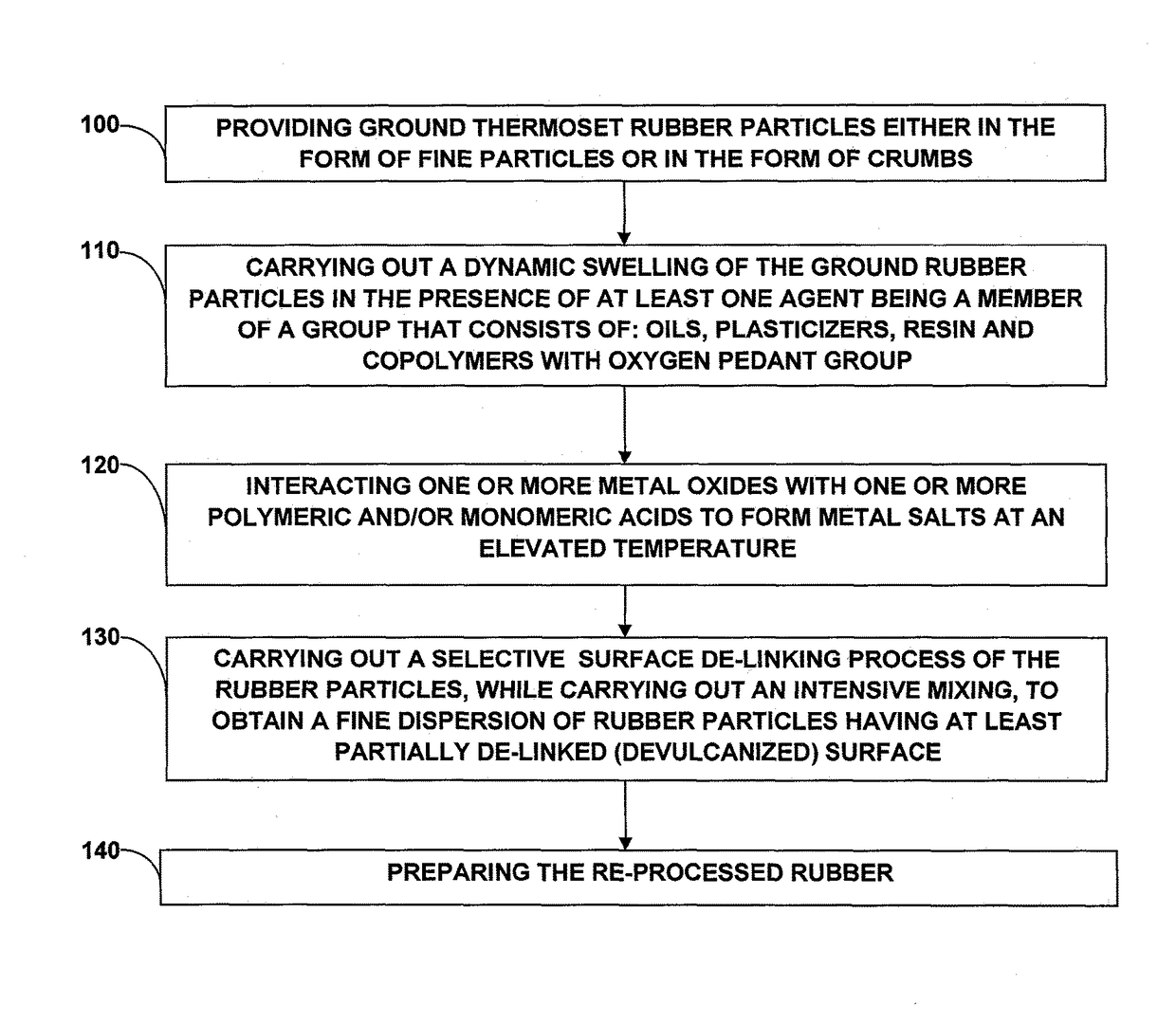Re-processed rubber and a method for producing same
a technology of thermoset rubber and reprocessing method, which is applied in the direction of plastic recycling, recycling and recovery technologies, etc., can solve the problems of burning tires, generating dangerous conditions of uncontrollable fires, and wasting resources, and achieves good rubber properties and high performan
- Summary
- Abstract
- Description
- Claims
- Application Information
AI Technical Summary
Benefits of technology
Problems solved by technology
Method used
Image
Examples
example 1
[0145]Example 1 demonstrates re-processed rubber in self-contained rubber blends. TRR base was produced while using ethylene copolymers with oxygen pendant groups and the compositions of the rubber crumbs with ethylene copolymers are shown in Table 1.
[0146]In addition, lower temperature reclamation was possible under higher shear stress conditions, since the heat stability of the crosslinks was reduced by means of the shear stress given to the vulcanized rubber and the thermoplastic resin.
[0147]TRR samples were produced while using ethylene copolymers with oxygen pendant groups. Compositions of such samples are presented in Table 2.
[0148]
TABLE 2GTR crumbE-1E-2E-3EcoTech 40 mesh100100100100EVA5EAA5EMA5
[0149]In various experiments conducted, the following amounts of de-linking agents were used:[0150]aromatic resin from about 3% to about 15% by weight, preferably about 8% by weight;[0151]Red oxide from about 0.2% to about 5% by weight, preferably about 2% by weight;[0152]Calcium hydrox...
example 2
Re-Processed Rubber in Co-Cured Rubber Blends with Virgin Elastomers
[0170]Re-processed rubber in co-cured rubber blends with virgin elastomers has fluidity and compatibility with a virgin rubber and can be dispersed finely throughout the virgin rubber. Accordingly, the re-processed rubber described above is capable of binding easily with the virgin rubber, resulting in rubber compositions containing such blends that have good rubber properties (Table 7).
[0171]In addition, since a rubber composition according to the present invention is a re-processed rubber which may be added to a virgin rubber, by doing so it replaces a corresponding amount of virgin rubber which consequently is saved. Depending on the performance requirements, at least about 10 phr to about 40 phr of fresh rubber may be substituted by the re-processed rubber of the present invention, without experiencing any significant loss of properties.
[0172]Preferably, the re-processed rubber would bind chemically to a virgin ...
example 3
[0181]Example 3 relates to samples containing re-processed rubber within self-contained rubber blends using acid precursor as active de-linking agent Diammonium phosphate (DAP) and Tricresylhosphate as swelling agent (TOP).
[0182]
TABLE 10Compositions of Rubber crumb with DAPE-7E-8EcoTech 40 mesh100100Diammonium phosphate—2Trioctyl Phosphate22
[0183]The delinking agents used, are the same as those used in Example 1.
[0184]
TABLE 11Gel content of TRR following de-linking operationE-7E-8Gel content, %8981Swelling in toluene, %325391
[0185]
TABLE 12Compositions of self-contained rubber blendsE-71E-81E-7100E-8100
[0186]The curing groups used for these samples are the same as those used in Example 1.
[0187]
TABLE 13Properties of the cured self-containedblends (MDR at 150° C. / 24 min)E-71E-81ML, lb-in0.90.9MH, lb-in4.25.1S″ @MH0.50.6TS2, min3.12.9TC 90, min4.55.3TC 100, min7.38.2
[0188]
TABLE 14Physical properties of the self-contained blendsE-71E-81Hardness Shore A6257100% Modulus MPa2.12.6200% Modul...
PUM
| Property | Measurement | Unit |
|---|---|---|
| elongation | aaaaa | aaaaa |
| tensile strength | aaaaa | aaaaa |
| elongation | aaaaa | aaaaa |
Abstract
Description
Claims
Application Information
 Login to View More
Login to View More - R&D
- Intellectual Property
- Life Sciences
- Materials
- Tech Scout
- Unparalleled Data Quality
- Higher Quality Content
- 60% Fewer Hallucinations
Browse by: Latest US Patents, China's latest patents, Technical Efficacy Thesaurus, Application Domain, Technology Topic, Popular Technical Reports.
© 2025 PatSnap. All rights reserved.Legal|Privacy policy|Modern Slavery Act Transparency Statement|Sitemap|About US| Contact US: help@patsnap.com

